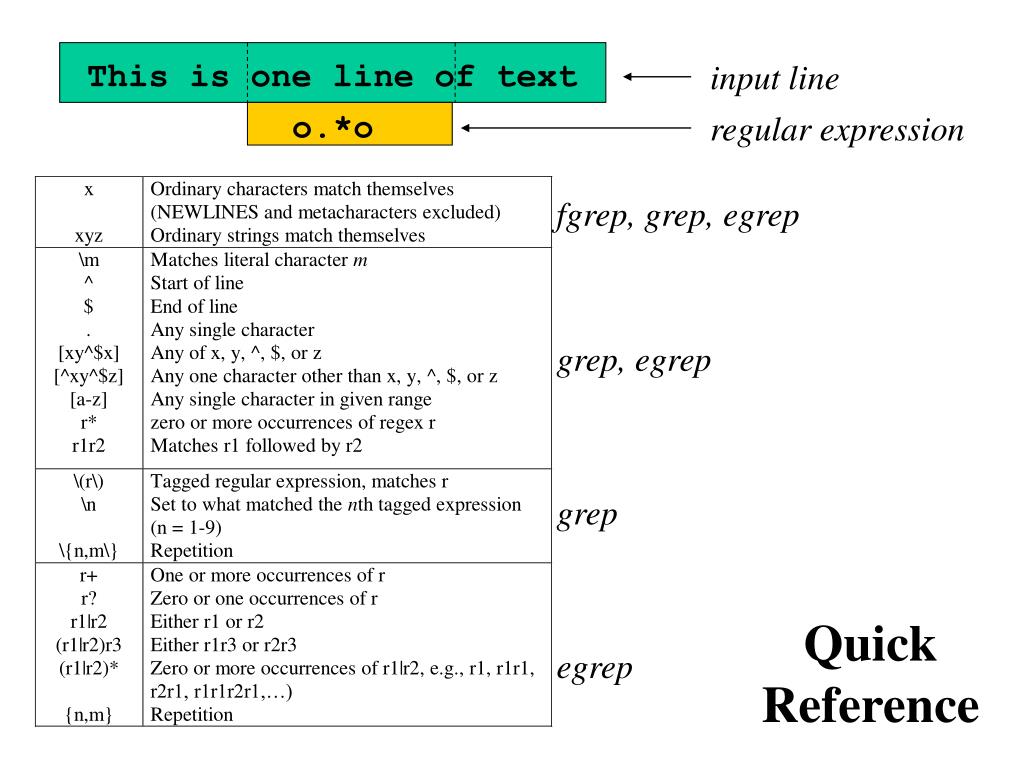

Matches one or more instances of the preceding character. Matches zero or more instances of the preceding character. Most characters in regular expressions match with input data literally however, there are some sequences that carry special significance: Symbol While straightforward pattern matching is sufficient for some filtering tasks, the true power of grep lies in its ability to use regular expressions for complex pattern matching. This filters the output of the ls command’s help text and looks for appearances of “dired”, and outputs them to standard out: -D, -dired generate output designed for Emacs' dired mode Regular Expression Overview For instance, given the following command: ls -help | grep "dired" Then, grep filters this output according to the match pattern specified and outputs only the matching lines. The output of any command or stream can be piped to the grep command. In addition to reading content from files, grep can read and filter text from standard input. This option can be used to protect a pattern beginning with “-”. If this option is used multiple times, search for all patterns given. Invert the sense of matching, to select non-matching lines. Show 2 (or another number of) context lines in addition to the matched line. Print the line number of each matched line.

Ignore case distinctions, so that characters that differ only in case match each other.
#PERL GREP REGEX FILE EEC FULL#
Output only the matching segment of each line, rather than the full contents of each matched line. Grep provides a number of powerful options to control its output: Flag Equivalent to the deprecated egrep command. If you need a more expressive regular expression syntax, grep is capable of accepting patterns in alternate formats with the following flags: Flag Patterns in grep are, by default, basic regular expressions. When run in recursive mode, grep outputs the full path to the file, followed by a colon, and the contents of the line that matches the pattern. When used on a specific file, grep only outputs the lines that contain the matching string. If you want to search multiple files, the -r flag enables recursive searching through a directory tree: grep -r "string" ~/thread/ The above sequence will search for all occurrences of “string” in the ~/threads file. The second (optional) argument is the name of a file to be searched. The first argument to grep is a search pattern. The Grep CommandĪ basic grep command uses the following syntax: grep "string" ~/threads.txt It is also provided as part of the common base selection of packages provided in nearly all distributions of Linux-based operating systems. This guide references recent versions of GNU grep, which are included by default in all images provided by Linode. This guide provides an overview of grep usage, a brief introduction to regular expression syntax, and practical examples. It is so ubiquitous that the verb “to grep” has emerged as a synonym for “to search.” grep is a useful tool for finding all occurrences of a search term in a selection of files, filtering a log file or stream, or as part of a script or chain of commands. I have always use as a command line, I don't know if you can access its methods directly from your perl programs but this would be very nice.Grep is a command-line utility that can search and filter text using a common regular expression syntax.
#PERL GREP REGEX FILE EEC PLUS#
This is a wonderful tool and as a plus you can have it also as a CPAN package. It implements, in perl, the grep functionality and extend it. Or find only the first match: $ perl -00 -wnl -e '/\bBRIBE\b/i and close ARGV ' SenQ.testimonyĪnd finally if you ask about grep and perl, I think thay I should mention ACK. So to preserve my pricing power, I refused it. My minimum bribe is $100k, and she only offered me $50k, In the last example ARGV is the current filehandle, and as with -l you are interested in finding files with the match you can print the file name and go for the next file after the first match in a file.Īlso you can search by paragraph instead by line: $ perl -00 -wnl -e '/\bBRIBE\b/i and print ' SenQ.testimony Perl -wnle '/foo/ and print $ARGV and close ARGV' null_1.txt null_2.txt # grep -l Perl -wnle '/foo/ and print "$ARGV: $_"' null.txt # grep -H

Here you have more examples inspired from the book: perl -wnle '/foo/ and print' null.txt # normal grep As you already accepted an answer, I am writing this answer for reference for future readers searching for similar problems, but not exactly yours:Īs people have answered already, the way of simulating grep with perl is to use the online approach.įor the use of perl as a 'better' grep (and find and cut and.) I recomend the book minimal perl and you are lucky because the chapter for 'perl as a "better" grep' is one of the sample chapters.


 0 kommentar(er)
0 kommentar(er)
